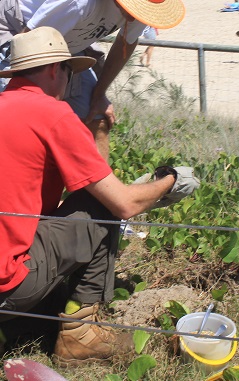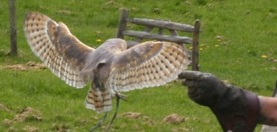 Learn about the management and day to day work involved in nature parks, wilderness reserves, forest parks, conservation landscapes, wildlife reserves and other such places.
Learn about the management and day to day work involved in nature parks, wilderness reserves, forest parks, conservation landscapes, wildlife reserves and other such places.
Nature Parks employ people in a wide variety of jobs, from park managers and rangers, to conservation officers, tour guides, gardeners and cleaners.
With 600 hours of study on the subject, across six modules, this course forms a very sound grounding for employment in any type of nature park.
Experiential based learning that not only builds a foundation knowledge and skills, but also helps you commence building your networking within the industry. You actually do things, see things and contact real people who are involved with nature parks. This is of fundamental importance in setting you on a course for career success and learning that continues building long past finishing the certificate.
COURSE STRUCTURE
The Certificate in Horticulture (Nature Park Management) is a vocationally oriented and IARC accredited course comprising both studies in both general horticulture and in nature park management.
This Certificate involves the areas of work:
- CORE STUDIES -Nature Park Management I and II
- STREAM STUDIES - a further four modules (see below)
CORE STUDIES
NATURE PARK MANAGEMENT I
1. Introduction to Nature Park Management – the role and scope of nature parks; the importance of indigenous vegetation in nature parks.
2. Basic Ecology – the environment, plants and animals; ecosystem concepts.
3. Soil Management in Nature Parks – soil characteristics and problems; earthworks.
4. Plant Maintenance – basic gardening techniques; natural gardening; plant selection; succession planting; equipment.
5. Design of Nature/Wilderness Parks I – collecting site information; preparing concept plans.
6. Design of Nature/Wilderness Parks II – drawing the final plan; construction estimates; designing animal enclosures.
7. Weed Management – characteristics of weeds; weed control; environmental weeds.
8. Pest and Disease Management – management strategies; chemical safety.
9. Culture of Indigenous Plants – techniques for establishing vegetation; planting design.
10. Tree Management – role of trees in nature parks; tree maintenance plans; pruning and tree surgery.
11. Turf Care – turf varieties in nature parks; lawn preparation, establishment and maintenance.
12. Rehabilitation: Problems and Solutions – aims and strategies; soil problems and solutions in degraded sites.
NATURE PARK MANAGEMENT II
1. Natural Environments – preserving natural environments; plant associations and environment rehabilitation
2. Recreation and the Environment – impact of recreation on natural environments
3. Wildlife Management in Nature Parks– impact of park visitors on wildlife; managing wildlife
4. Visitor Amenities in Nature Parks – design; provision of visitor amenities including picnic areas and campgrounds; management of facilities
5. Park Interpretation – interpretative facilities including signs and education programs
6. Trail Design and Construction – designing access routes in parks; designing and constructing walking tracks
7. Water Areas – conserving and managing natural water bodies in Nature Park, impact of humans on water areas
8. Marketing Nature Parks – strategies used to promote nature parks
9. Risk Management I – identifying, minimising and managing natural hazards; safety issues
10. Risk Management II – preparing a risk management plan
STREAM STUDIES
Choose any additional four modules from the following courses (Click on modules titles for more details):
Ecotour Management
Ecotour Tour Guide Course
Introduction to Ecology
Wildlife Management
Conservation and Environmental Management
Ornithology
Practical Horticulture I
Marine Studies I
Vertebrate Zoology
Animal Health Care
Environmental Assessment
Duration: 600 hrs
Accredited through International Accreditation & Recognition Council
Why study with ACS?
- Established in 1979
- Learning focused, practical training
- regularly revised courses that respond to industry needs and changes
- tutor support from experienced and highly qualified tutors working in the industry
- flexible learning - start whenever suits you and study at your own pace
- Internationally recognised and accredited through IARC
__________________________________________________________________________
MANAGING WILDLIFE
 An article by staff of ACS Distance Education
An article by staff of ACS Distance Education
What is involved in Wildlife Management?
Similar to humans, animals in the wild have needs such as food, shelter, reproduction and movement. The area that a wild animal normally lives in is known as its habitat, which provides the animal's resources and environmental conditions. Wildlife management is the manipulation of wild animal populations and their habitats in the context of an ecosystem. Wildlife management includes activities such as:
- managing parks and reserves
- altering and rehabilitating wildlife habitats
- providing education and extension programs for special interest groups
- maintaining threatened populations and pests at a desirable level
- protecting human life and property and
- managing harvests of wildlife.
Conserving or controlling populations of wildlife may take one of the following forms:
1. Managing wildlife habitats
2. Managing people
3. Managing individuals in populations so that the population will either change or remain constant.
The techniques and types of wildlife management vary depending on your location, and as with any job, you will find that you will need to carry out research into the local methods and types of wildlife management. This course is designed to give students a broad-based introduction to the principles and practices of wildlife management common to many species around the globe.
Approaches to Wildlife Management
Preservation
Wildlife preservation is where wildlife managers try to leave a population or habitat in its natural state. Active management may be required to maintain or recreate naturally occurring populations of animals and plants. Basically, areas are protected from destruction and are left so that nature takes its course. When nature takes its course, it may not always be favourable for the wildlife involved as change is inevitable in natural systems. The survival of the American Whooping Crane is an example of Preservation. The population size of this species has grown from a critical level of 15 individuals to just under 300 species due to the preservation of key breeding sites such as Wood Buffalo National Park.
Conservation
Conservation can have various meanings to different groups. In this course, conservation means that wildlife managers are actively managing a natural system to maintain and use natural resources in such as way as to preserve its biodiversity for future generations of humans and animals. For example, in Uganda, East Africa, statutes are in place to allow for the protection of wildlife whilst allowing managers to sustainably harvest resources such as timber.
Management
Management is the focus of this course. It involves the manipulation of populations to achieve specific objectives for wildlife and humans. This manipulation may be in order to increase the size of the population, to “harvest” animals in a sustainable way or to reduce or stabilise a population. Management can be applied to both pest and desirable species. For example, across most of Australia, the red fox is a major pest species due to its success as a predator of native wildlife and livestock. Wildlife managers are attempting to control this population through a baiting program in conjunction with trapping and shooting.
Purpose of Wildlife Management
There are many different reasons why we might want to manage wildlife and the relative importance of those reasons can vary from place to place, both within a country and around the world. This importance can also change from time to time.
Managing a particular species may be critical in one country, where for various reasons it has become a pest; while the same species may in a different country be controlled by nature with very little need for intervention by man. For example, wild rabbit populations in the UK are largely controlled by natural predators such as foxes. But in Australia, wild rabbits (an introduced species) have few to no natural predators and in some cases have reached pest proportions on a grand scale, threatening habitats and competing with native species for resources.
Reasons for managing wildlife may (among other things) include:
- The population of an animal may be increasing in excess of its available resources, which may then be impacting (or may impact) on other species (plant and animal).
- Inadvertent introduction of a non-indigenous species to an area may have changed the balance of nature.
- Climate change, abnormal events (eg. natural disaster) or development activity may have changed or caused instability in the balance of nature.
- Control of disease carried by animals (Diseases that affect domestic animals, livestock, other wildlife and even humans).
- Conserving threatened species.
- Studying different species.
- Sustainable harvesting of a resource (eg. fish populations in the oceans).
- Protecting individual animals from unnecessary or unethical harm. (eg. Control of elephant poaching in Africa).
Goals of Wildlife Management
The goals of wildlife management vary considerably with the situation. Goals of wildlife management plans can include:
- maintain a desirable population at a healthy level.
- reduce the population of an undesirable species.
- allow for sustainable removal of animals from a population – for example, harvesting wildlife for meat.
- increase numbers of an endangered species.
Decisions to be Made
Three decisions need to be made to effectively manage wildlife.
- What is the desired goal?
- Which management option is appropriate based on the goal? and
- By which action is the management option best achieved?
The first decision requires a value judgment. The other two require technical judgments.
Who makes the Decisions?
Decisions in wildlife management should be made in consultation with a range of stakeholders that may be affected by or have an interest in the decision being made. Decisions are not the sole right or responsibility of the wildlife manager. Stakeholders in wildlife management may include landholders, local residents, environmental groups, hunters and pet owners.
It is up to the wildlife manager, as part of their role, to appreciate that these people need to be involved in and have an influence upon any decision made in regards to the management of wildlife. Once a decision has been made, and goals have been set, it is the wildlife manager’s responsibility to implement these decisions.
The Right Decision
Decisions regarding wildlife populations can be far reaching and have a significant impact upon the environment. In order to determine whether a specific goal is the correct one, one needs to consider the impact of reaching the correct decision, and the impact of making the wrong one.
Value judgments can neither be considered to be right or wrong, but do have a big influence in the decision making process. For example, some people would argue for the elimination of a species based on an intrinsic dislike of an animal (for example, snakes), whereas other people would provide ethical reasons for why this species should be allowed to survive. Technical reasons for a view (such as the fact that snakes can pose a risk to human health) are possibly more valid in decision making, but need to be combined with value judgments in order to make the best decision taking into account the needs of both humans and wildlife.
Important Concepts
All animals require three basic factors for survival
- Food
- Water
- Habitat (shelter and sufficient space)
What is good wildlife habitat?
A good habitat is any environment where animal species can occur, survive and reproduce.
There are five main types of habitat:
- Large trees (both living and dead)
- Understorey habitats (eg. trees and shrubs of varying sizes)
- Dry ground habitats (eg. rocks, logs, ground cover plants and grasslands)
- Wet ground habitats (eg. beaches, mangroves and wetlands)
- Aquatic habitats (eg. marine, estuaries and lakes)
Limiting Factor
A limiting factor is any factor that restricts the wildlife population from growing by causing mortality or affecting birth rates. Essentially this will be the habitat requirement that is in short supply, such as food, water or shelter. For example, the presence and distribution of tree hollows for raising young can be a limiting factor to the success of certain parrot populations.
Carrying Capacity
Carrying capacity relates to the ability of the habitat to support certain species. The carrying capacity can be maintained or increased by managing a limiting factor. Carrying capacity is particularly evident in island populations. This concept is addressed in greater detail in Lesson 5.
Succession
This concept refers to the replacement of an existing biological community with another. This usually occurs in an orderly change to the composition or structure of a community. Several stages of succession can significantly increase wildlife diversity. However, wildlife managers need to be mindful of the effect of succession on vulnerable wildlife when planning for their management. Whilst some species may thrive with changes to a biological community, it may produce deteriorating conditions for others. For example, the threatened bobwhite quail (Colinus virginianus) of Central America and Ontario shows a clear preference for early successional vegetation created by disturbances such as fire. Therefore, to manage habitat for the bobwhite's survival, succession needs to be halted through active management.
Landscape Fragmentation
Fragmented landscapes are those which become smaller and more isolated over a period of time. Fragmentation factors which effect wildlife include habitat patch size, distribution, edge length and corridors.
WILL THIS COURSE GET YOU A JOB?
 There are many points that need to be considered when you are looking for work and having a qualification is just one of them:
There are many points that need to be considered when you are looking for work and having a qualification is just one of them:
Are you studying the right course? A good course
will help you to not only gain knowledge in the field of study it will
also help you to experience actual situations that you may encounter in
the work place. This is called ‘Experiential Learning’ many courses
concentrate on ‘Competency Based Learning’ – just ticking you off
against a known list of tasks. Experiential or Problem Based Learning
will help you to develop those problem solving skills that are much
sought after in employees by commerce and industry.
Are your studies broad enough? In horticulture for
example to narrow your focus on one industry sector also narrows your
opportunities. A Certificate in Horticulture (core units) will give you
those under-pinning horticulture skills that are needed in many horticultural industry sectors but also in environmental jobs - so many courses lack the plant knowledge and skills needed to help ensure environmental sustainability. You can then use these basic skills
to specialise in Nature Park Management. Should you however want to
change sectors later you can still do so because of those basic
horticultural skills you acquired by undertaking those fundamental core
units are relevant to all industry sectors in horticulture.
Are you lifting your profile? No matter what job we
are in or hope to get into, networking is the best way to get your name
out there and be noticed. Join online social media groups such as
linked-in to establish a profile. Make sure you keep it up to date and
list your educational and work experience, you would be surprised how
many job offers come through these types of networks. Network with
industry – attend seminars, industry exhibitions, garden shows etc. and
make yourself known; someone may remember you later!
Are your communication skills good? We all remember a
good communicator. Communication is not just about being able to hold a
conversation with someone though, it also includes writing and
technology skills. Today it is essential for everyone to have basic
computer skills, good telephone techniques, a respectful way of speaking
with others and knowing what is acceptable and non-acceptable behaviour
in the workplace.
Are you well-presented? In some horticultural jobs
it is almost impossible not to get dirty! Flower growing or crop growing
or landscaping is all dirty work. However when presenting yourself for
jobs you should be dressed in clean appropriate attire for the job
interview you are attending. When you front up for work in the morning
do so in clean clothes – it is too easy to think that you’ll get dirty
anyway. A tidily presented person will stand out and be more likely to
get ahead in their jobs than one who turns up at work in yesterday’s
dirty clothes. If you are running your own business good presentation
also evokes a feeling of confidence both from you to the customer and
from the customer towards you.
Have you chosen the right school? Not all education
providers are equal – some will push you through your course just to get
you to the end. Others require you to study within set time frames and
others give you little support. Many are more about getting that
government funding than they are about educating their students.
At ACS:
- We are independent: we do not rely on nor apply for government
funding - we are a self-funded school – so we are less caught up in
bureaucracy and more into educating our students.
- We allow our students to take their time - when you enrol your
course starts - not at a set time of the year. You can then work work
your way through the course, with our support, putting in as little or
as much time as you can. You can fit your studies around your work or
your personal situation.
- We support our students through their studies: we encourage
them to contact us and help us to help them, as soon as the smallest
problems arise or if they need more information or clarification.
- We want you to succeed!
ENROL AND LEARN